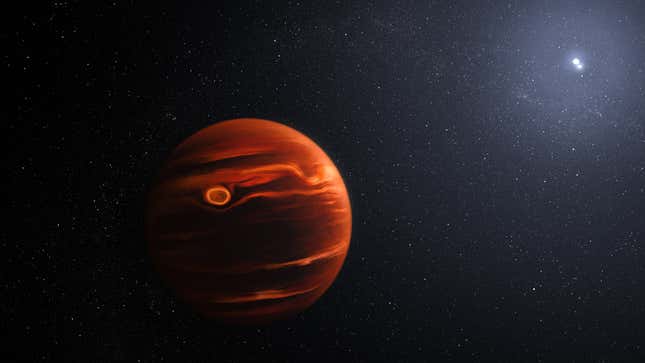
The Webb Space Telescope just turned its infrared gaze at an exoplanet and found dense clouds swirling in the atmosphere of this quirky world.
The planet—VHS 1256b—has a 22-hour day but sits extraordinarily far from the two stars it orbits, themselves rotating close together at the center of the system. Astronomers used Webb’s Near Infrared Spectrograph (NIRSpec) and the Mid-Infrared Instrument (MIRI) to observe the planet, and they found that its upper atmosphere appears to have silicate clouds with the consistency of smoke. Deeper in the planet, clouds made of larger grains seem to be more silty. Unlike Earth’s clouds, the exoplanet’s clouds are piping hot—about as hot as a candle flame, according to a Space Telescope Science Institute release.
A NASA post describes the clouds as “swirling” and “gritty” and notes that the changes in brightness caused by the movements of the clouds “are so dramatic that it is the most variable planetary-mass object known to date.”
VHS 1256b is about four times as far from its host stars as Pluto is to the Sun, meaning one of its years is the length of 10,000 Earth years.
The astronomers also detected clear signs of water, methane, and carbon monoxide, as well as some signs of carbon dioxide. Exactly how these molecules manifest on the planet—what clouds they might swirl in, or how deep they sit in the planet—is not yet clear.
“Webb’s high-resolution data are stressing our existing models,” said Polychronis Patapis, an astronomer ETH Zurich in Switzerland, in the STScI release. “Existing models can ingest one or two features, but not as many as Webb has shown us of this target.”
It’s hardly Webb’s first foray into exoplanet observation. The $10 billion space observatory is still in its first year of scientific observations, but it has already released a dazzling portfolio of space imagery.
An exoplanet spectrum was included with Webb’s first Early Science Observation releases, a testament to how important alien worlds are to the mission’s science goals. Webb detected its first carbon dioxide on another world in August and followed that up in September with its first images of an exoplanet. In November, it revealed a noxious exoplanet atmosphere and found an entirely new exoplanet this January.
VHS 1256b is another piece in the exoplanetary jigsaw. Astronomically speaking, the planet is relatively young, at 150 million years old (now we’re talking in Earth years again). And for reference, our planet is about 4.6 billion years old.
As VHS 1256b ages, scientists believe it will cool off, and the hefty cloud cover in its skies may dissipate. Until then, the planet stews in its own hot, cloudy mess.
More: Newest Webb Image Is a Stunning View of a Star’s Penultimate Stage

